Customer segmentation tools help businesses organize and classify clients into distinct groups based on shared characteristics such as behaviors or demographics. Companies can then tailor products, services, and marketing efforts to meet the specific needs of each segment.
But how can you determine which software is the right choice for your business?
We’ve got you covered—
We’ve spent hours analyzing and reviewing various customer segmentation software, and here’s a comparison table of the ones that came on top:
| Name | Rating | Free plan | Best for |
|---|---|---|---|
| Tidio | 4.7/5 ⭐️ | ✅ | Pre-chat survey |
| Segment | 4.5/5 ⭐️ | ✅ | Allows multiple integrations |
| Survicate | 4.6/5 ⭐️ | ✅ | Customizable survey templates |
| Heap | 4.4/5 ⭐️ | ✅ | Advanced Reporting |
| Zendesk | 4.3/5 ⭐️ | ❌ | Net promoter scores |
| Userpilot | 4.6/5 ⭐️ | ❌ | In-app surveys |
| HubSpot | 4.4/5 ⭐️ | ✅ | Shared inbox |
| Mixpanel | 4.6/5 ⭐️ | ✅ | Granular data analysis |
| Qualtrics | 4.4/5 ⭐️ | ✅ | Interactive dashboard |
| MailChimp | 4.4/5 ⭐️ | ✅ | Customer journey triggers |
Now, let’s get straight to the point—
What is the best customer segmentation software in the market?
10 best customer segmentation tools
As promised, let’s dig into some of the audience segmentation tools we can recommend to businesses that want to understand their customer base better.
Here are the top software to help you with your segmentation strategy:
1. Tidio
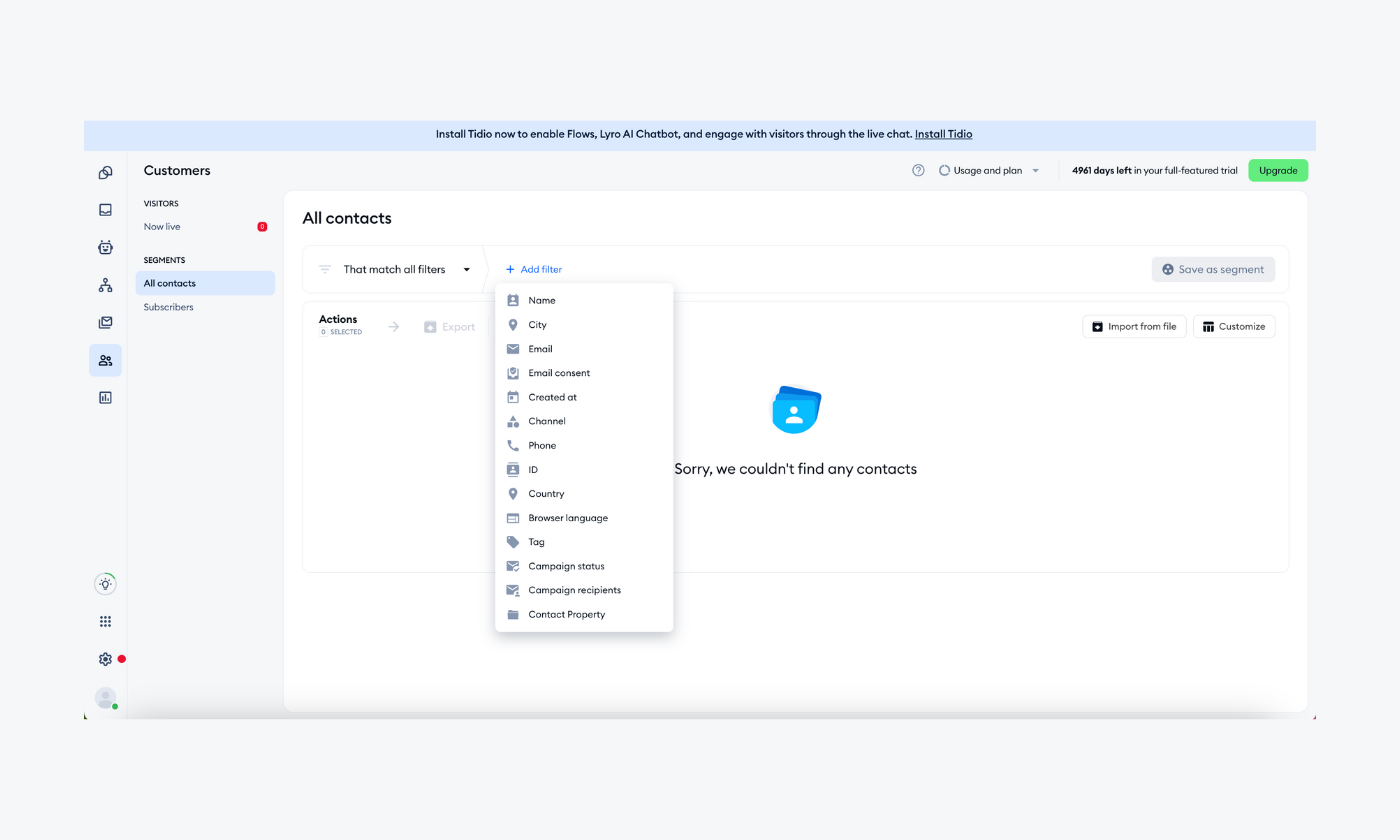
Rating: 4.7/5 ⭐️ (1,520+ reviews)
Tidio offers a user-friendly, comprehensive customer segmentation system that’s designed specifically for small to mid-sized businesses (SMBs) and ecommerce ventures. This platform empowers support teams to deliver outstanding customer service seamlessly across various channels through a single inbox. This brand offers multichannel support, conversational AI, and customizable help desk templates to enhance your customer interactions.
You can segment return visitors from new arrivals and add contact properties for repeat clients. On top of that, users can segment tag visitors and track their results with analytics tools.
Main features:
- Shared inbox tool
- Pre- and post-chat surveys
- Live view of website visitors
- Custom agent notifications
- Variety of segments and tags
- 7-day free trial available
- Free version available
- Starter ($29/mo)
- Growth (starts at $59/mo)
- Plus (starts at $749/mo)
- Premium (starts at $2999/mo)
Segment your customers on autopilot
Read more: Learn how to install Tidio on your website in a few simple steps.
2. Segment
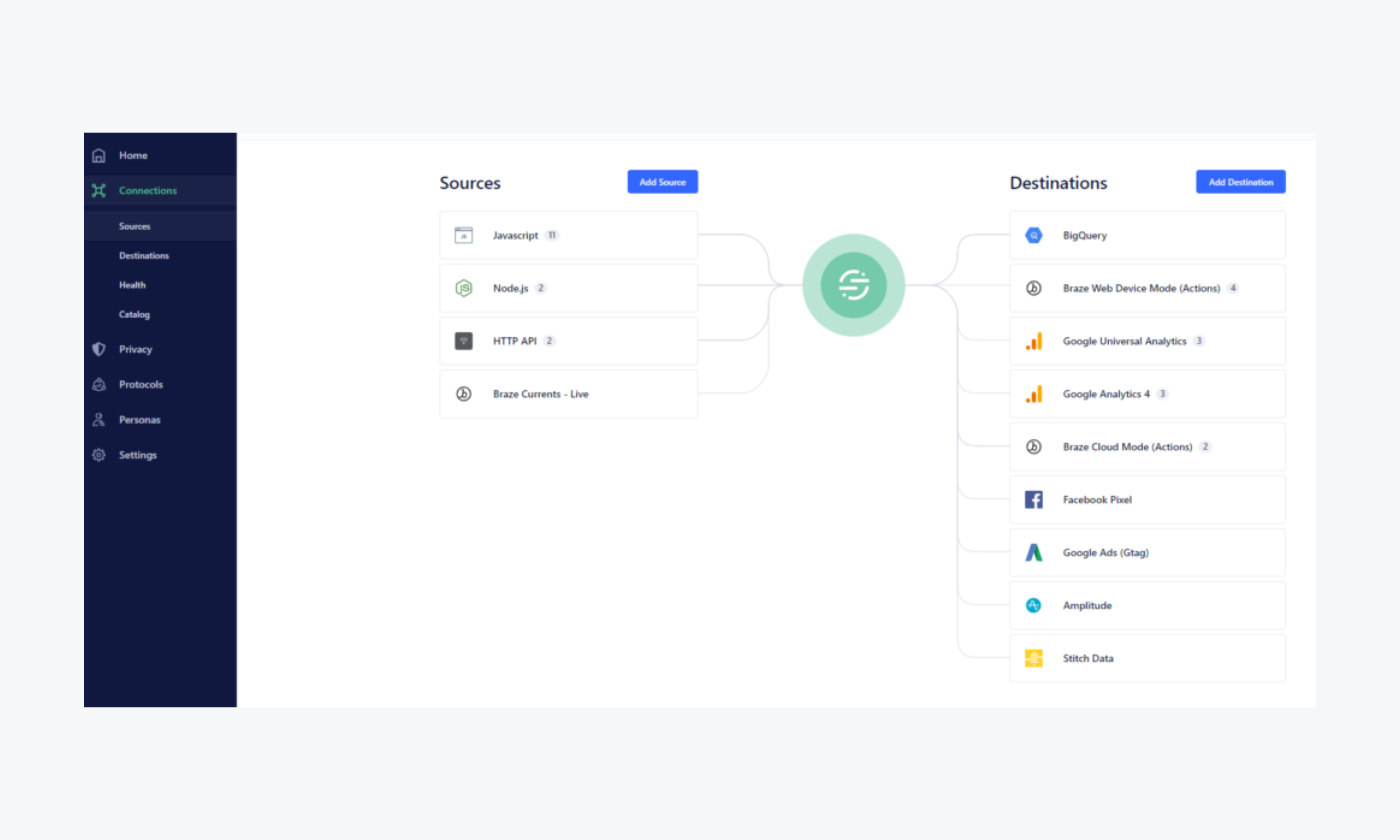
Rating: 4.5/5 ⭐️ (550+ reviews)
Segment is a customer segmentation software that is unrivaled in consolidating groups of customers in-app. You can also use it alongside other integrations to get actionable insights that benefit your marketing team. Moreover, cross-channel engagement creates personalized customer journeys across various touchpoints, allowing marketers to tailor and curate for target audiences based on context.
On top of that, data pipelines generated from deploying the system in your business allows you to route it to other apps such as Mixpanel and Google Analytics for synthesis.
Pros:
- Several security features
- Variety of integration available
- Advanced data collection capabilities
Cons:
- New users will require a learning curve
- Reportedly unpredictable support response times
- Free version available
- Team ($120/mo)
- Business → contact sales team
3. Survicate
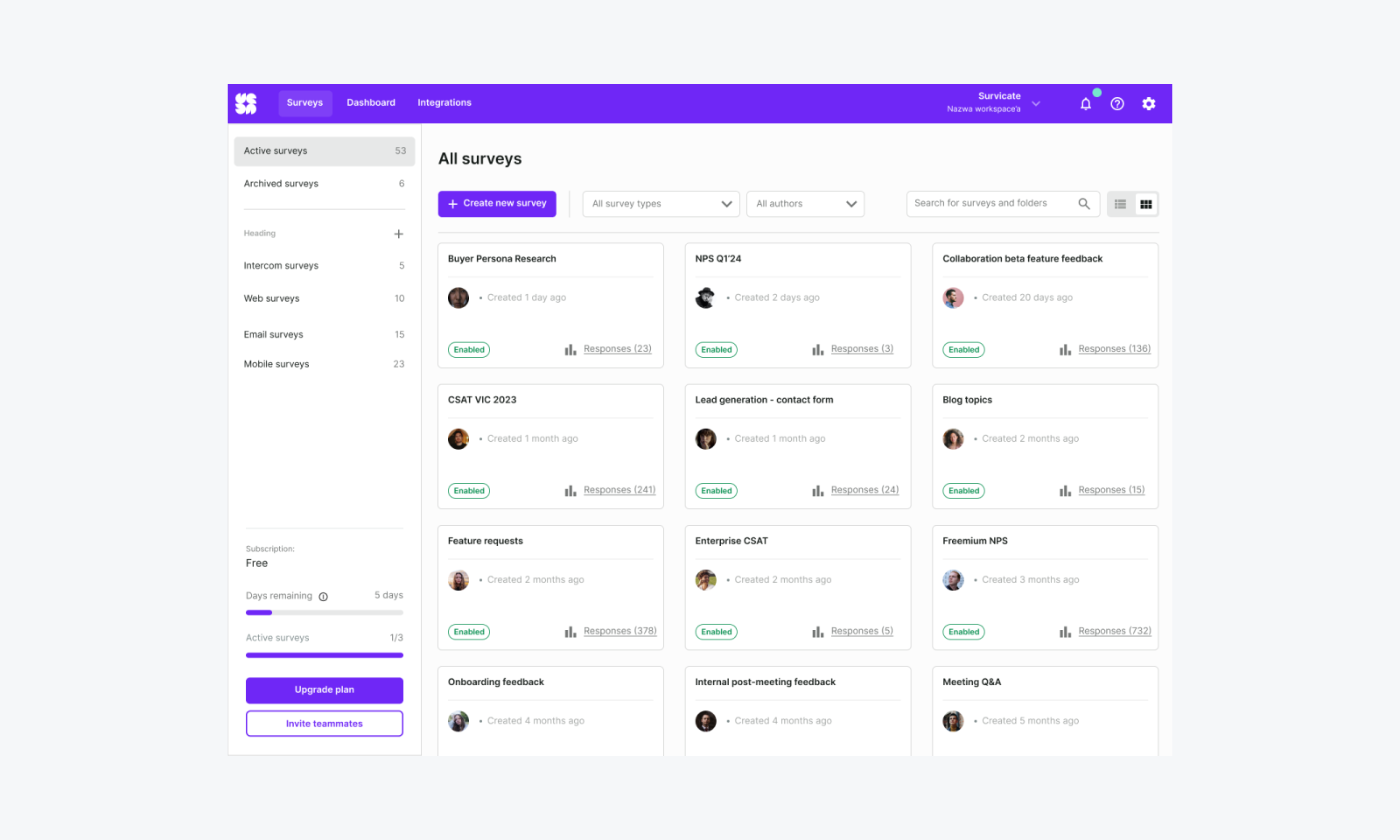
Rating: 4.6/5 ⭐️ (165+ reviews)
Survicate software is a customizable and intuitive feedback management tool. It’s great for CX managers to understand different visitor groups from their data pools and tailor communications accordingly.
This customer segmentation platform collects reviews from people and subjects it to analysis, which identifies patterns and trends that can help you run more targeted marketing campaigns. As a business, you can run CSAT score questions to gauge client satisfaction with one or all of your products and services.
Pros:
- Customizable survey templates
- Prompt customer support
- Easily integrated with internal systems
Cons:
- Limitations to advanced targeting
- Doesn’t allow complex routing
- Free version available
- Business ($99/mo)
- Scale ($299/mo)
4. Heap
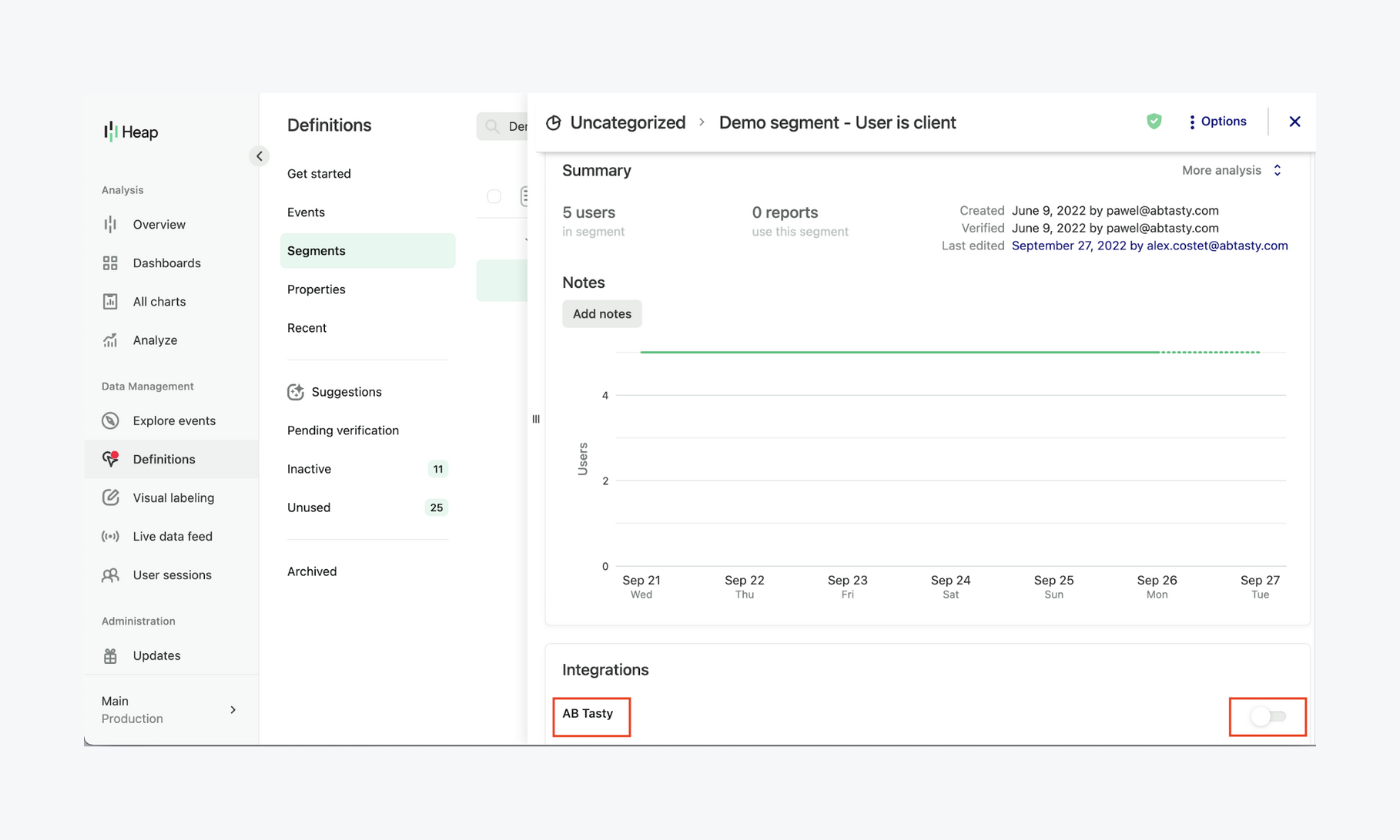
Rating: 4.4/5 ⭐️ (1,085+ reviews)
Heap is a digital insights platform that maps out the customer’s online journeys. It’s a great tool for internal marketing and customer experience managers to focus on churn, conversion rates, customer retention, and satisfaction.
This is one of the best customer segmentation solutions, making it easy for anyone to grasp analytics, especially with the help of the CoPilot feature. All your customer data on user interaction is captured automatically to give you a smart understanding of how the different segments engage with your business. You can choose to segment users based on their age, gender, purchase history, product usage, interest, lifestyle, and values.
Pros:
- Advanced reporting tools
- Great for product analytics
- Compatible with web, Android, iOS & third-party applications
Cons:
- Getting started with a visual analyzer tool is tedious
- Automated data tracking can overwhelm the sheer volume of data collected
- Free version available
- Growth → contact sales team
- Pro → contact sales team
- Premier → contact sales team
5. Zendesk
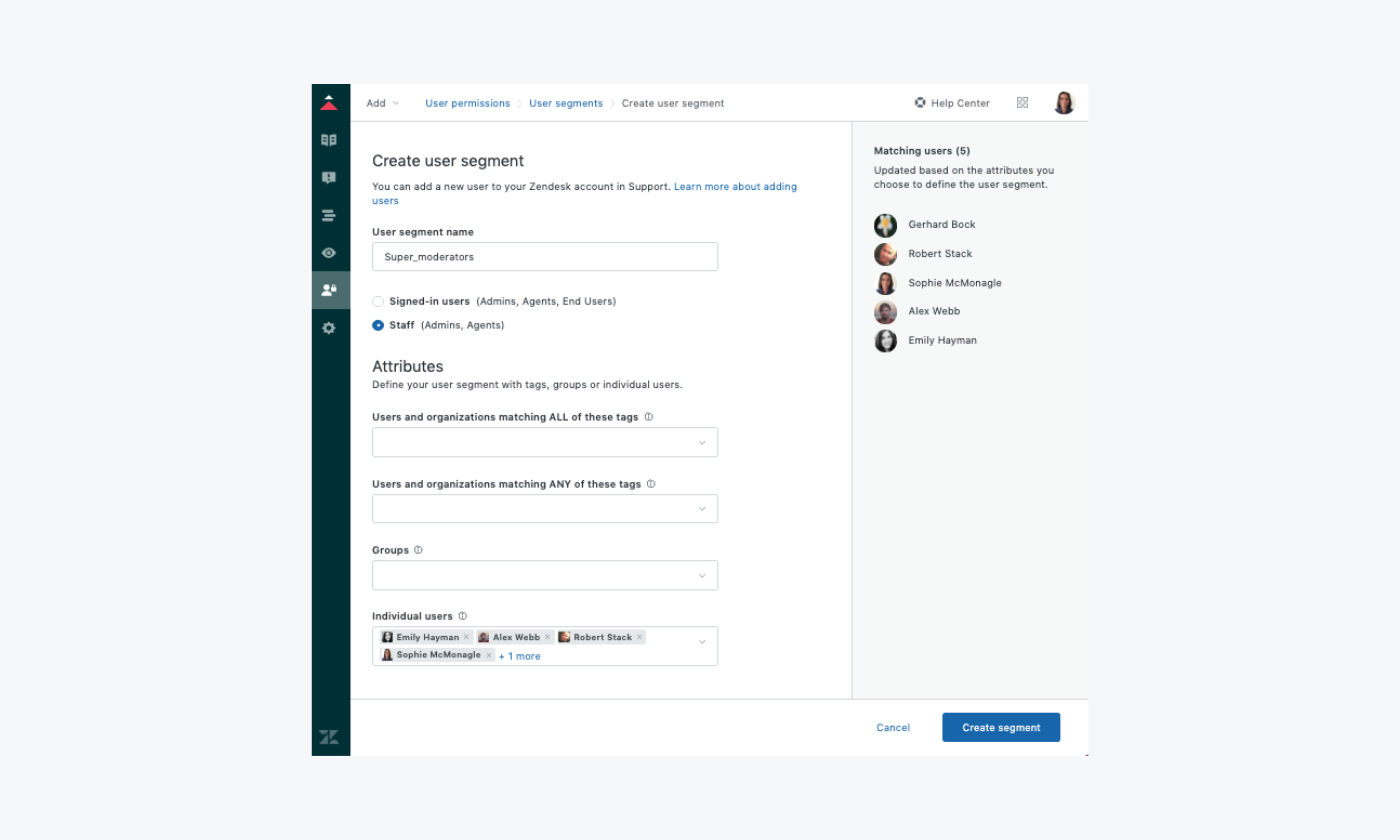
Rating: 4.3/5 ⭐️ (5,855+ reviews)
Zendesk is a customer data platform that relies on artificial intelligence, collected metrics, and other forms of emerging technology. It offers ticket tagging and categorization to help you sort the incoming customer inquiries.
You can measure customer net promoter score and other metrics that gauge loyalty and customer satisfaction using analytics. This will ensure that you prioritize and assign tickets more efficiently. This segmentation marketing software helps you collect customer feedback and analyze it directly through embedded surveys, landing page feedback, and customizable per-ticket basis.
Pros:
- Surveys and polls available
- Issue tracking and assignment
- Robust reporting and analytics
Cons:
- The sudden rollout of new interfaces can be disruptive
- Analytics tool could be more intuitive
- Free 14-day trial available
- Suite Team ($55/mo/agent)
- Suite Growth ($89/mo/agent)
- Suite Professional ($115/mo/agent)
- Suite Enterprise and Suite Enterprise Plus → contact sales team
Read more: Check out the top Zendesk alternatives with pros, cons, and pricing compared.
Make customer segmentation easy using the best tool on the market
6. Userpilot
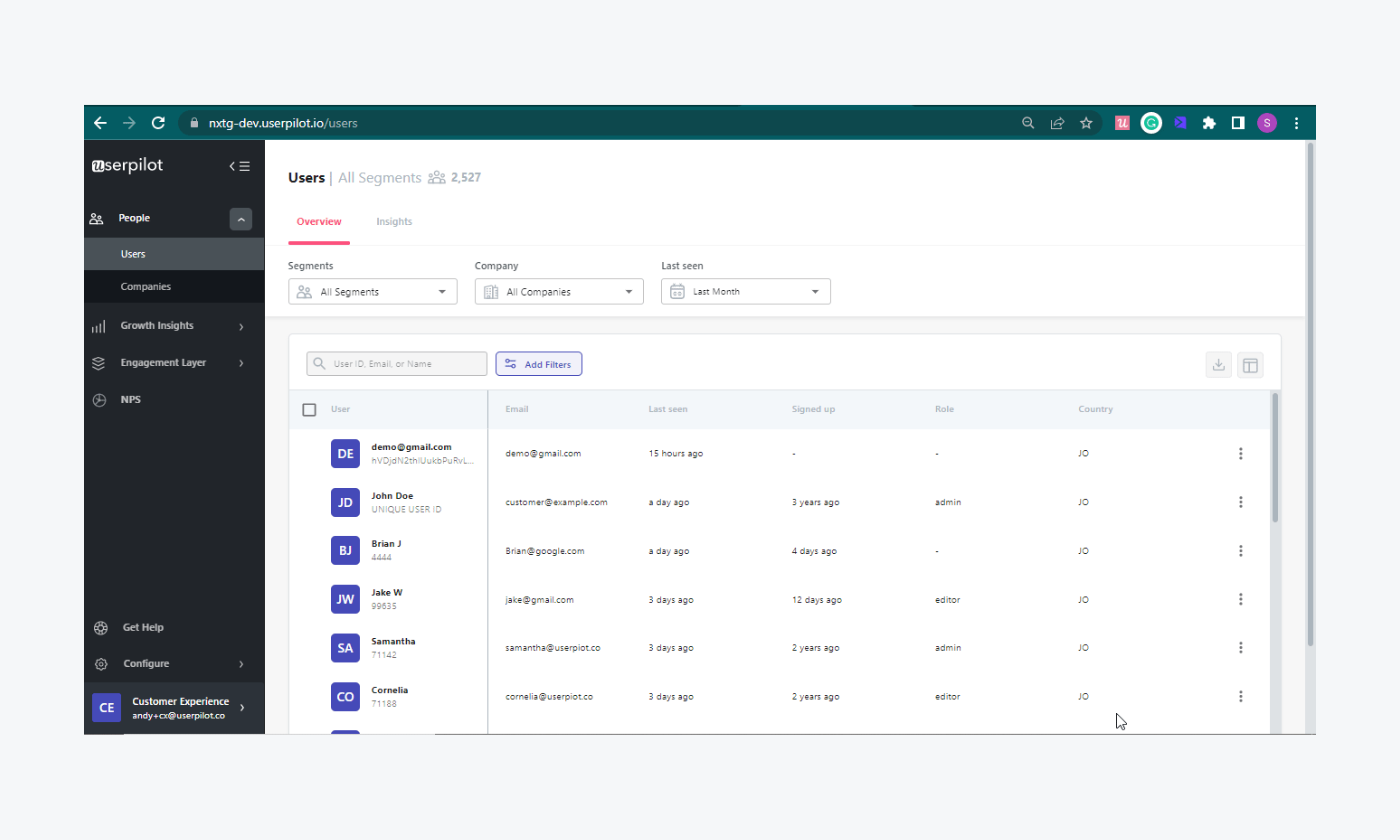
Rating: 4.6/5 ⭐️ (395+ reviews)
Userpilot is a customer segmentation software renowned for its product analytics, onboarding features, and in-app surveys. On top of tracking data, businesses can also run surveys targeting users who drop off from the funnel and collect insights on improving the onboarding experience for higher retention.
You can further run data-driven experiments on Userpilot based on the data collected to assist brands to validate controlled product experiments and ideas. Moreover, iterate the survey forms where necessary and eventually improve the user experience.
Pros:
- User onboarding tools
- Customizable analytic reporting
- In-app surveys available
Cons:
- Incapable of integrating with Microsoft’s Power BI and Zapier
- The builder may face issues affecting action when tracking in flows
- Starter ($249/mo)
- Growth ($749/mo)
- Enterprise → contact sales team
7. HubSpot
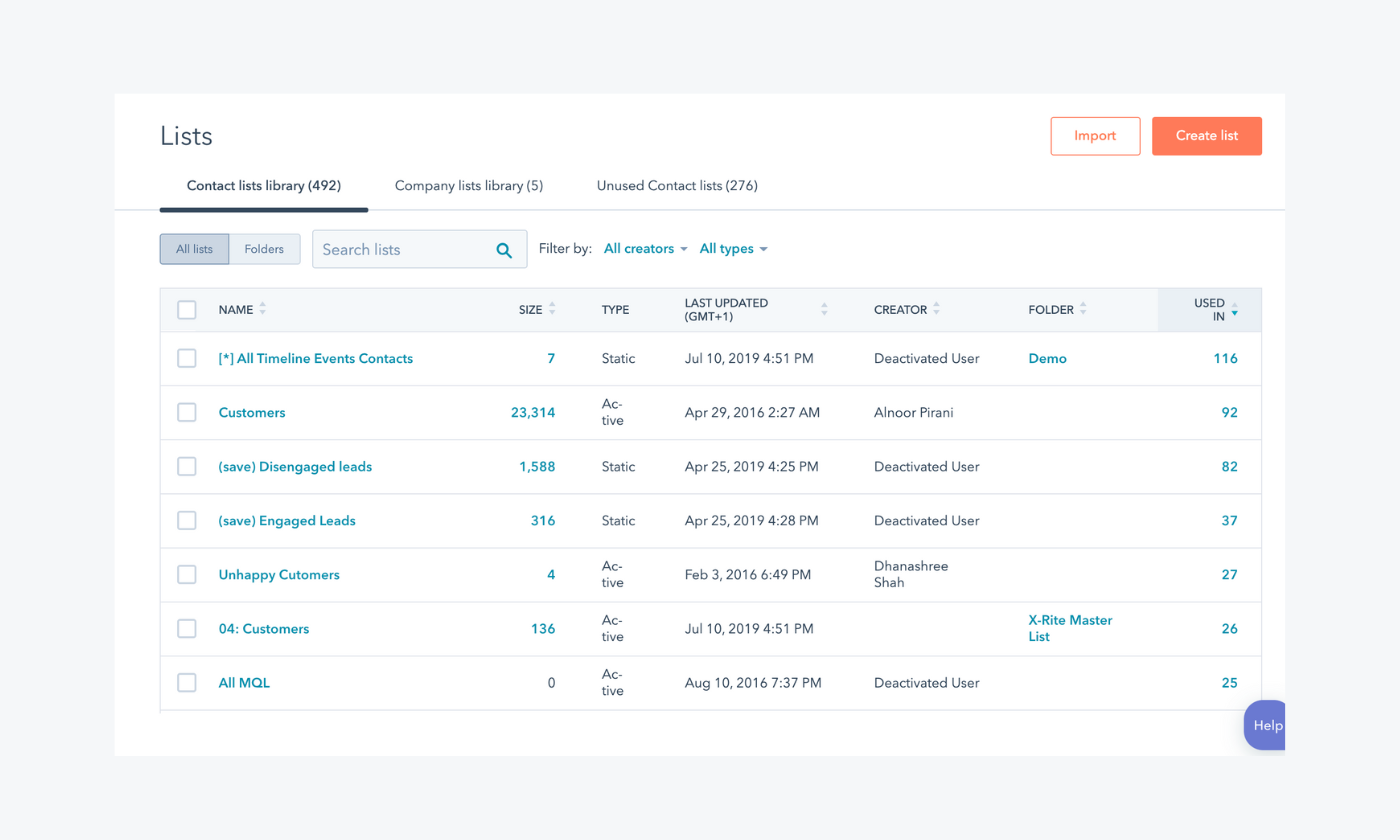
Rating: 4.4/5 ⭐️ (2,295+ reviews)
HubSpot is a business segmentation tool that helps you segment contacts based on data stored in the centralized CRM system. You can collect the information that prospects share of their interests. These data points will aid brands to tailor your marketing to customer needs. On top of that, a list segmentation helps to create contacts across wide criteria from age, content download, and deal size.
This audience segmentation platform automates up-to-date contact records designed to streamline email marketing campaigns to deliver tailored and personalized experiences. You can also run time-based triggers to pop up right on time.
Pros:
- Shared inbox management
- Workflow automation features
- Automated follow-up surveys
Cons:
- Needs more secured access controls for information-sensitive industries
- As a cloud-only service, the hub is inaccessible during internet downtimes
- Free version available
- Starter ($20/mo/seat)
- Professional Customer Platform ($1,180/mo)
- Enterprise Customer Platform ($3,910/mo)
Read more: Compare the best HubSpot alternatives available today.
8. Mixpanel
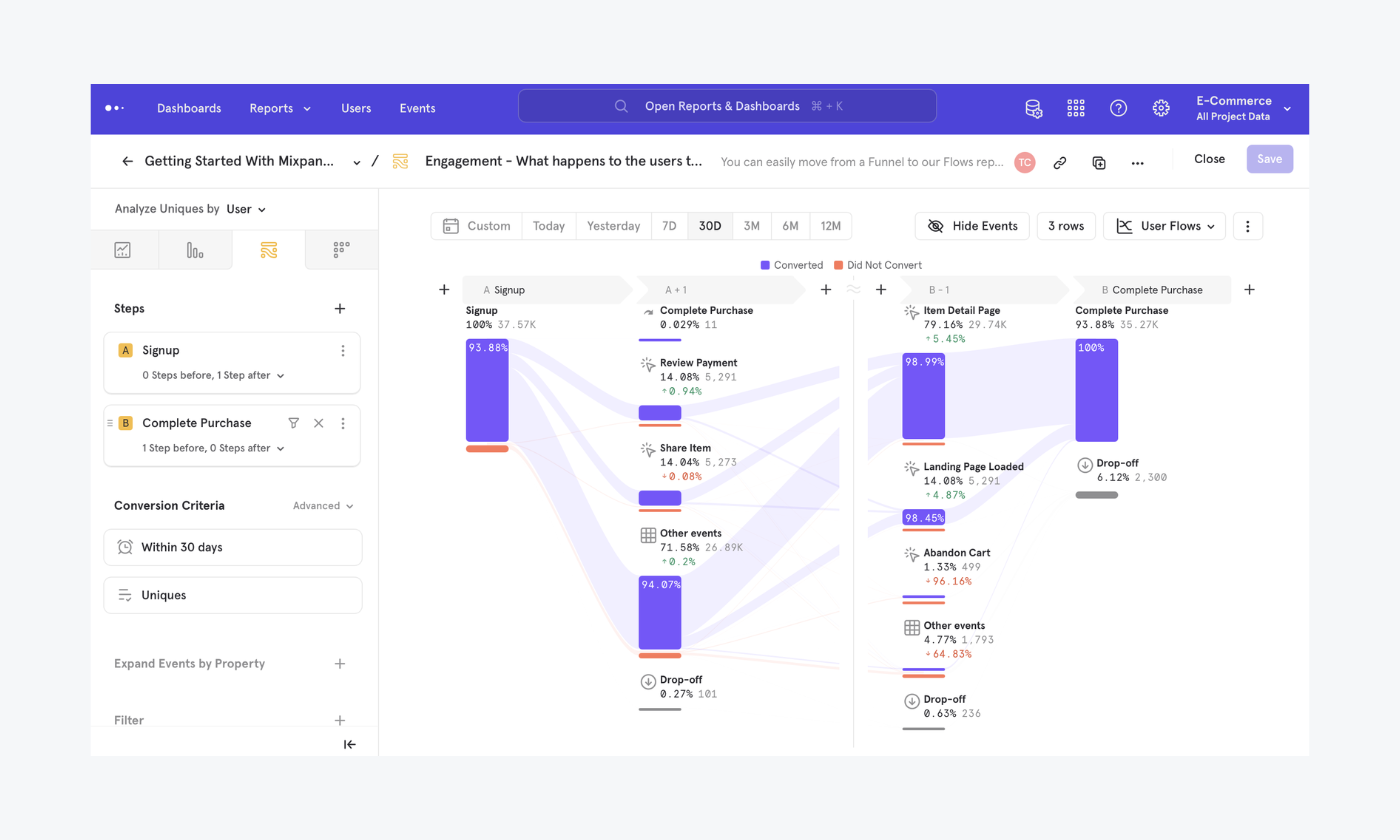
Rating: 4.6/5 ⭐️ (1,095+ reviews)
Mixpanel is a powerful analytics tool that helps product teams track and analyze their client engagement. Funnels let you follow customer progress toward certain desired outcomes such as conversion. Moreover, the A/B testing helps support teams create cohorts and customer profiles on users based on common traits or experiences.
This customer segmentation technology provides data points linked with unique user IDs on custom events like cart additions, sign-ups, and interactions. Moreover, the advanced functionality helps to filter customers based on product usage, user feedback, and in-app behavior enabling the trigger flows of personalized marketing messages.
Pros:
- Data analysis at a granular level
- Unlimited segmentation capability
- Simple to navigate user interface
Cons:
- Doesn’t allow global filters on dashboard reports
- Inadequate advertising of the full range of features
- Free version available
- Growth ($28/mo)
- Enterprise → contact sales team
9. Qualtrics
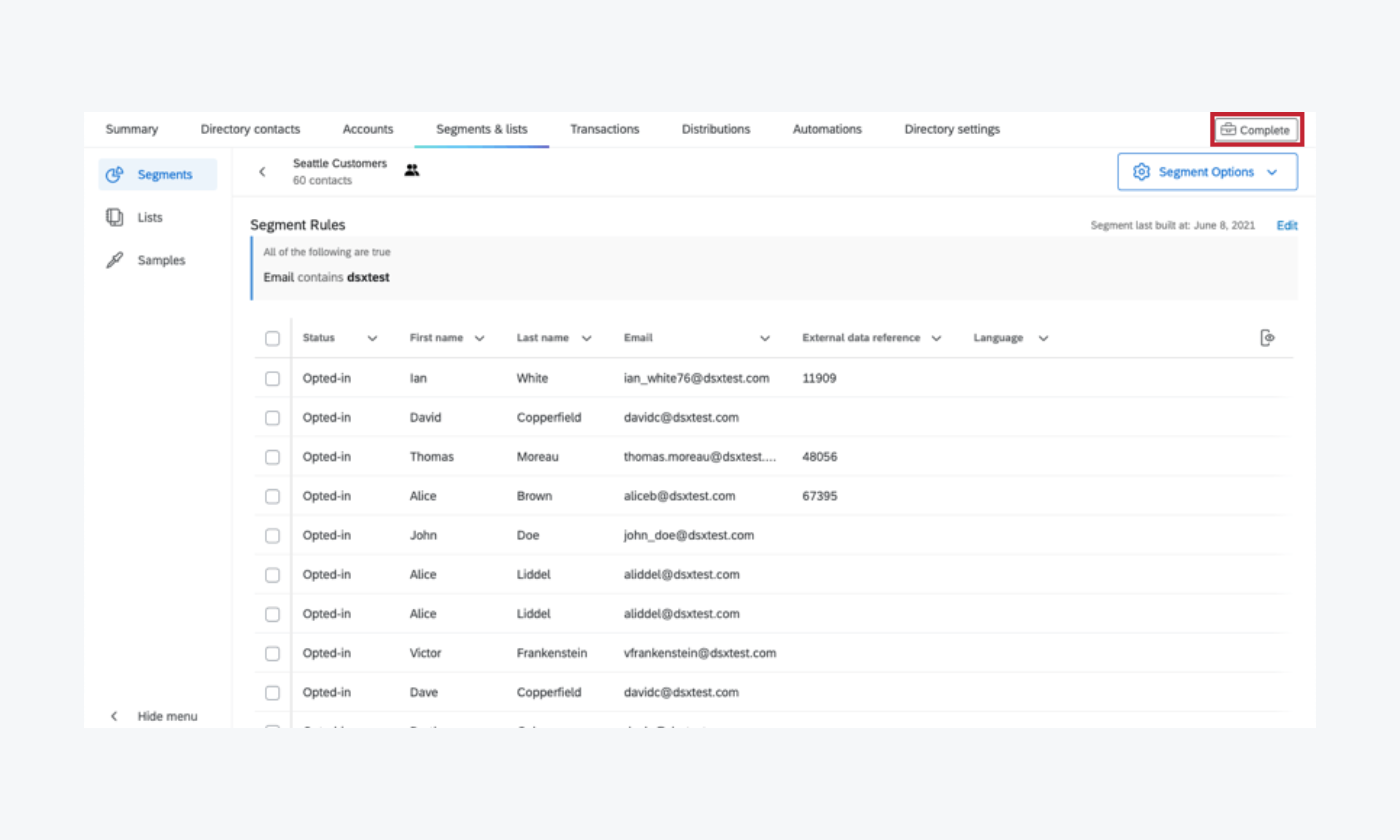
Rating: 4.4/5 ⭐️ (530+ reviews)
Qualtrics accesses customer data and divides it into segments that can assist in targeted outreach. Features such as DesignXM and CustomerXM help to design products customers want, increase market share, and make data-driven decisions.
The Qualtrics Experience iD helps to capture signals drawn from all communication channels in order to assist in grouping customers based on their profiles and capture granular data. This market segmentation software can also boost engagement and retention of your website visitors.
Pros:
- Customizable templates
- Conversational assist
- AI-powered analytics
Cons:
- A range of questions offering different scales and valuations
- Reporting requires more flexibility
- Frontline digital → contact sales team
- Frontline care → contact sales team
- Frontline locations → contact sales team
10. MailChimp
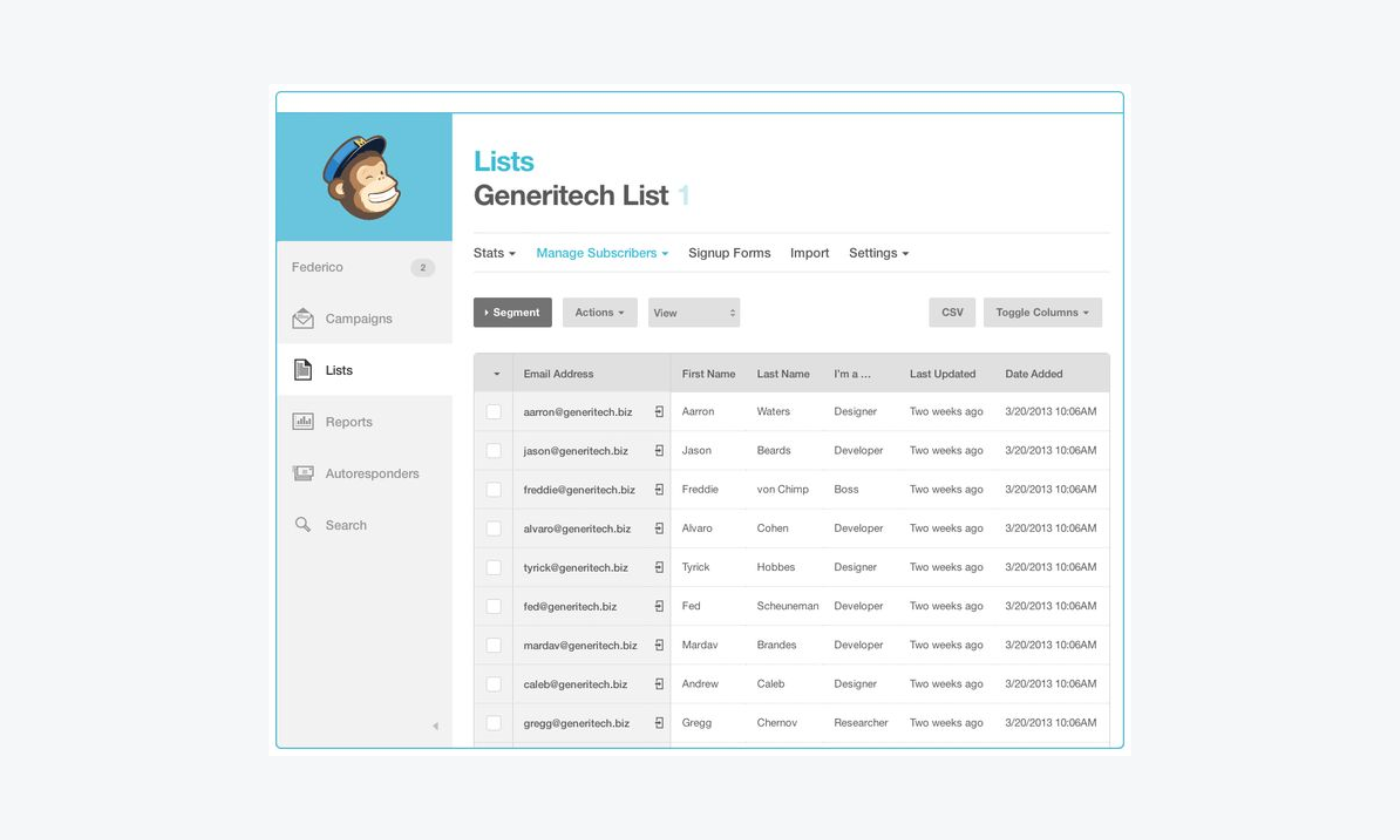
Rating: 4.4/5 ⭐️ (5,175+ reviews)
MailChimp is a customer profiling software with features that provide an in-depth view of your audience. It also allows you to design email campaigns based on consumer segments. This helps to boost orders and customer lifetime value through personalized emails based on purchasing data.
On top of that, you can create fast and generative AI effortlessly with on-brand content accompanied by intelligent tools originating from expertly designed templates. The audience segmentation system targets customers with advanced logic as per their spending amounts, predicted attributes, and buying behavior. MailChimp also optimizes customer data by generating custom reports according to industry benchmarks with a funnel visualization.
Pros:
- Customer journey triggers
- Detailed analytics and reporting
- Intuitive design and user-friendly interface
Cons:
- Slow support team response
- Advanced email automation features need improvements
- Free plan
- Standard ($20/mo)
- Premium ($350/mo)
- Essentials ($13/mo)
Now that we know some of the top customer segmentation tools in the market, let’s look at the benefits of market segmentation tools to a business.
Benefits of customer segmentation tools
No matter the marketing automation approach you deploy as a business, some elements of targeting and personalization are necessary for achieving the best results. Marketing segmentation software helps you meet those needs and better understand your customer.
Here are some of the benefits of customer segmentation backed by data:
Data organization
Customer segmentation software using AI helps with pattern recognition by analyzing customer data and running predictive modeling. Meanwhile, machine learning algorithms analyze complex data sets to pinpoint patterns and trends. And according to Harvard Business Review, 48% of businesses run ML and AL to point out sales prospects.
Accuracy
Collecting data from various channels and consistently applying the criteria to all data sets guarantees uniformity. Moreover, real-time segmentation updates ensure current consumer behaviors and preferences are reflected. This is important as studies show that organizations that automate their marketing gain $5.44 for every dollar spent.
Better targeting
Businesses can better tailor their products when they identify specific customer segments. And according to HubSpot, segmented emails lead to a 30% increase in opens and a 50% boost in click-through rates compared to unsegmented emails.
Read more: See how a tuxedo rental company, achieved 85% customer service automation with AI chatbots.
Wait, that’s not all—
Here’s a look at what top customer segmentation software is composed of.
Key features of a customer segmentation system
Essential segmentation features include the ones that will eliminate pain points of potential customers in SaaS companies, ecommerce businesses, and service providers alike. The software should be able to provide user segments based on customer behavior, demographics, and other tags.
Here are the key features you should look out for:
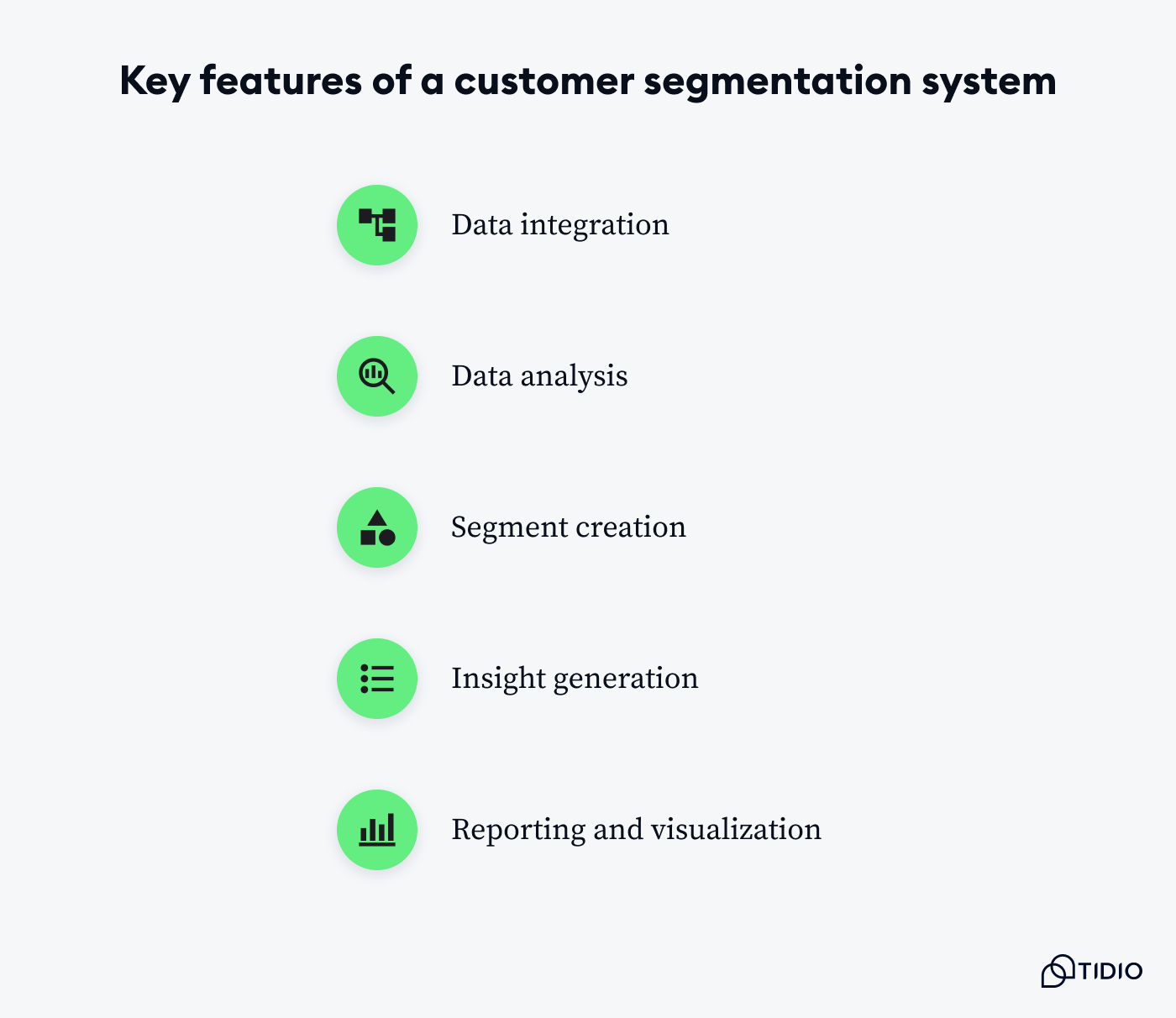
Data integration
Customer segmentation technology collects and combines user data within the CRM, including buyer records, website interactions, and social media engagement. This gives a clear understanding of the complete customer journey.
Check if the software can:
- Export and import data
- Has API integrations
- Offers data cleansing
Data analysis
Statistical algorithms enable businesses to filter through integrated data when identifying patterns such as high-value customers or frequent buyers. This helps to create accurate profiles for your target audience.
Look if the software contains:
- Predictive analytics
- Behavioral tracking
- Reports and visualization
Segment creation
Based on the analysis, customer segment groupings share similar traits such as demographics, purchase history, and behavior. This helps with sales strategies and other forms of personalized marketing.
Ensure your software offers:
- Custom criteria.
- Dynamic segmentation
- Tags and groupings
- Cross-channel segmentation
- User-friendly interface
Insight generation
The software should provide actionable insights when interpreting data patterns and other behavioral segmentation. These insights help in decision-making as you run marketing campaigns, improve customer service, and develop new products.
Look for a software that offers:
- Trend analysis
- Customer lifetime value reports
- Opportunities detection
- Actionable recommendations
Reporting and visualization
The software provides visual representations of data and other segments that can be easily interpreted. Check if the software provides:
- Custom dashboards
- Data charts and graphs
- Real-time reports
- Exported reports
Let’s now have a look at some tips and use cases for market segmentation tool that will help you increase customer engagement.
Best practices for implementing customer segmentation solutions
Advanced segmentation of new customers and repeated visitors is based on user behavior analytics.
Here are general tips you can implement for your customer segmentation system to gain the key data points:
Have a clear plan identifying data types and sources worth tracking
This includes establishing data sets based on which you’ll measure results. Once you have the KPIs, implement them across different data sources. Your data collection from forms and surveys should contain multiple-choice questions, parameters, and other questions that help collect valid inputs.
Look for patterns
Prioritize data before empirical evidence when determining the most useful ways to segment customers. In that case, remove any outliers that might affect running a segmentation analysis.
Avoid surface-level outlook
Marketers and hypotheses pay keen attention to their customer base. However not many test their theories and experiments.
For instance, if you want to effectively analyze conversions from newsletter subscribers and non-subscribers, you can use your audience segmentation software.
The system will analyze the frequency of purchases made by subscribers and non-subscribers to see how they differ. Then, motivate customers with lower spending habits to sign up for your newsletter while keeping an eye on how often they make purchases
How to choose the right customer profiling software for your business?
As we have covered above, marketing segmentation tools vary in how they integrate data sources, how they can scale, and how complex the segmentation they analyze is. When choosing a suitable customer segmentation solution, you can begin by answering the following questions:
- What’s your goal—ensure it’s in line with your marketing strategy and caters to future plans
- Are there unique customer segmentation opportunities—advanced customer segmentation software can categorize users according to demographics and customer psychographics
- Can you track performance over time—a system of your choice should have built-in descriptive analytics to benchmark how segments have progressed with time
- Are there personalized marketing experiences—proper data segmentation categorizes specific customer groups, which can later be key when running marketing campaigns
Customer segmentation tools: key takeaway
No customer is similar to another, so the best way to get better marketing outcomes is to adopt multiple approaches. With customer segmentation, your business will understand the user better and will be able to align the right tactics and strategies to meet their unique needs.
Some of the best customer segmentation services available on the market include:
- Tidio
- Segment
- Survicate
- Heap
- Zendesk
- Userpilot
- HubSpot
- Mixpanel
- Qualtrics
- MailChimp
You can get started and start segmenting your audience using Tidio’s free version today.
Automate your customer segmentation

